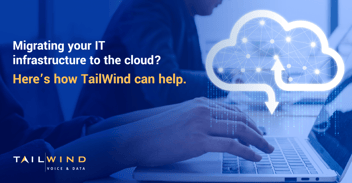More and more businesses are moving to the cloud, and for good reason. The value cloud services generate from enabling organizations to innovate is worth more than five times what’s possible through IT cost reductions.1 But while the cloud opens up a world of flexibility and scale, managing it all can quickly become overwhelming.
That's where managed cloud services come in. These services allow businesses to offload day-to-day cloud operations to a managed services provider (MSP) – and it's an increasingly popular option, with 60% of organizations opting to outsource public cloud management to an MSP this year.2
But what exactly does a cloud managed services provider do, and are they right for your business? Below, we’ll break down the definition, benefits, and potential challenges to help you decide.
What Are Cloud Managed Services? A Brief Definition
Managed cloud services involve handing off routine cloud management tasks to a third-party provider. Instead of managing every aspect of your cloud environment in-house, a managed services provider steps in to keep everything running smoothly.
What Is A Managed Cloud Service Provider (MCSP)?
A managed cloud service provider (MCSP) is a vendor that delivers ongoing operations, optimization, and support for your cloud environments. An MCSP may work directly with your hyperscaler (AWS, Azure, Google Cloud) or operate as an independent third-party. Services are typically offered on a subscription basis and can either supplement your in-house team (co-managed) or fully replace day-to-day cloud management.
Typical MCSP capabilities include: monitoring and alerting, cost governance and rightsizing, security hardening and patching, backup and disaster recovery, performance tuning, compliance reporting, and change management aligned to SLAs.

Cloud Managed Services Examples
Cost Governance
Systematic cost control across clouds through rightsizing, non-prod start/stop schedules, and commitment planning (Reserved/Committed Use). Anomaly detection and budget alerts prevent surprise charges, while monthly variance reviews keep spend aligned to business goals.
Backup & Disaster Recovery
Cross-region, immutable backups with defined RPO/RTO targets and quarterly failover tests. Runbooks, automated validation, and recovery drills reduce downtime risk and ensure critical data and services can be restored quickly and predictably.
Security Hardening
Baseline hardening against CIS benchmarks, regular patch cadence, encrypted storage/transport, and least-privilege IAM. Continuous vulnerability scanning and policy-as-code guardrails remediate drift and misconfigurations before they become incidents.
Observability
Unified logs, metrics, and traces with SLO dashboards and synthetic testing for key user journeys. Noise-reduced alerting and clear runbooks shorten mean time to detect and recover (MTTD/MTTR) and keep teams focused on genuine signals.
Identity & Access
Centralized SSO/MFA, just-in-time privileged access, and quarterly access reviews. Segmented roles, key rotation, and “break-glass” workflows balance security with operational agility across multi-account and multi-cloud estates.
Workspace (DaaS)
Managed virtual desktops and application workspaces for distributed teams. Standardized images, policy-based updates, and autoscaling improve rollout speed, reduce helpdesk tickets, and support secure access from any device or location.
How Do Cloud Managed IT Services Work? 7 Keys Areas They Cover
In most cases, a cloud managed services provider will function as an extension of your IT team. Your in-house team keeps its strategic IT focus, while the MSP manages cloud-specific responsibilities like:
- Infrastructure monitoring and alerting
- Resource and cost optimization
- Security patching and vulnerability management
- Cloud backup and disaster recovery
- Software and service provisioning
- Performance tuning and reporting
- Compliance support and audits
Your organization still maintains ownership and control over your systems. The MSP simply brings in the extra hands – and expertise – to help your cloud environments stay secure, efficient, and aligned with your goals.
Co-Managed vs Fully Managed
- Co-Managed: The provider runs day-to-day operations while your team owns roadmap, architecture, and approvals. Best when you want to keep strategic control.
- Fully Managed: The provider handles operations and change execution under defined SLAs, with governance via quarterly reviews. Best when you need 24/7 coverage and faster execution.
Automation & Safe Deployments
Infrastructure-as-Code and standardized CI/CD pipelines enable blue-green or canary releases with automated rollback. This reduces human error, shortens release cycles, and improves reliability.
SLAs, SLOs & Shared Responsibility
Service Levels
- Uptime Targets: 99.9%+ for managed components.
- Incident Response: P1 acknowledge in 15 minutes; status updates until resolution.
- Resolution Objectives: MTTR targets by severity; post-incident reviews within 5 business days.
- Change Windows: Standard vs emergency changes, with documented rollback plans.
Shared Responsibility
- Provider: Day-to-day operations, patching, security controls, monitoring, backup/DR testing, compliance reporting.
- You: Data classification and retention, identity policies, approved change requests, business continuity priorities.
7 Benefits Of Cloud Managed Services
Managed cloud services aren’t just about saving time. When done right, they can bring real value to your business in several ways:
1. Cost Savings
Flexera’s 2025 State of the Cloud Report revealed that 84% of IT professionals struggle to manage cloud spend.2 Managed service providers make it easier to save on cloud services by reducing the need to hire specialized staff, purchase monitoring tools, or maintain redundant systems. Plus, they can help eliminate unnecessary cloud spending by fine-tuning how you use resources, so you can stay on budget while still meeting performance expectations.

2. Governance & Spend Control
Tagging standards, budgets, and policy-as-code keep environments compliant and spend visible. Monthly variance reviews and automated guardrails prevent resource sprawl and surprise charges.
3. Scalability
Scaling your cloud infrastructure as your business grows can get complicated. A cloud managed IT services provider can help you expand without overcommitting resources or risking downtime during transitions – whether you're adding new users, rolling out new apps, or opening a new office.
4. Improved Performance & Uptime
When your cloud systems are tuned and maintained by experts, performance improves. MSPs work proactively to distribute workloads, reduce bottlenecks, and configure your infrastructure for stability. That means smoother experiences for your employees and customers, with fewer interruptions.
5. Access To Experts
Managing a cloud platform takes more than general IT knowledge. Managed cloud providers bring expertise in platforms like AWS, Microsoft Azure, or Google Cloud, giving you access to specialists who can guide decisions and troubleshoot issues effectively.
6. 24/7 Monitoring & Support
Cloud systems don’t keep regular business hours, and neither do potential threats. Cloud managed services providers offer around-the-clock monitoring and support, giving you peace of mind that someone’s always watching over your systems and ready to respond when needed.
7. Stronger Security & Compliance
Cloud security incidents increased by 154% in 2024, and 61% of businesses reported significant disruptions.3 Cloud managed IT services help lower your risk without stretching your internal team thin by managing access policies, data encryption, regular patching, and ongoing compliance support.
How We Measure Success
- Idle or over-provisioned spend reduced
- Uptime/SLO attainment increased
- Mean Time to Detect/Recover (MTTD/MTTR) reduced
- Patch latency and critical vulnerability backlog reduced
- Failed deployments reduced; change lead time faster
- Backup success rate and DR test pass rate increased

Real World Use Cases For Managed Cloud Services
There are many situations where managed cloud services can make a difference. Here are a few examples:
Hybrid Cloud Management
Many organizations use a mix of on-premises systems and cloud infrastructure, and a managed cloud services provider helps ensure they work together correctly.
Workload Migration
Moving legacy systems or applications into a cloud environment can be especially challenging for multi-location organizations. MSPs can guide this transition while minimizing downtime and preserving data integrity.
Disaster Recovery Planning
Managed cloud services help businesses put reliable backup and recovery plans in place to protect critical systems from data loss or outages.
Security Enhancements
Cloud MSPs improve security by applying best practices, running vulnerability scans, and offering compliance support tailored to your industry.
Cloud Cost Optimization
Cloud environments can get expensive quickly, but managed service providers regularly audit resource usage and right-size infrastructure to help you stay within budget.
Managed Cloud Challenges & Considerations
While the advantages of managed cloud are clear, it’s also important to understand potential drawbacks, such as:
Loss Of Direct Control
Outsourcing some parts of your cloud environment means you may no longer have the same level of hands-on control or visibility. It’s important to work with a provider that values transparency, offers detailed reporting, and includes you in decision-making.
Mitigation: Enable admin audit logs, require change approvals, and hold monthly governance reviews to maintain visibility and authority.
Security & Trust
Bringing in a third party means trusting them with your data and systems. Do your due diligence by asking about their security certifications, data handling practices, and incident response plans before handing over control.
Mitigation: Require SOC 2 or ISO 27001, segment access, use customer-managed keys, and schedule independent third-party security audits.

Vendor Lock-In
Depending on how services are structured, some providers may lock you into proprietary tools or processes that make it hard to switch later. Look for partners that prioritize flexibility and portability.
Mitigation: Mandate IaC deliverables (e.g., Terraform/ARM), config/runbook handoff, portability standards, and a documented exit plan with timelines.
Variable Costs
Though managed services usually reduce internal costs, the subscription-based nature of managed services can lead to unexpected charges if not properly managed. Be sure to review contracts carefully and ask for clear details around pricing and service levels.
Mitigation: Use a published rate card, strict change-control, budget alerts, and quarterly rightsizing/savings reviews.
Is Managed Cloud The Right Choice For Your Business?
Choosing a cloud-managed services model might be a strong fit if your organization:
- Doesn’t have the bandwidth or expertise to manage cloud workloads internally
- Wants to simplify operations across multiple cloud platforms
- Needs to speed up the time to value from cloud investments
- Struggles to meet regulatory requirements or industry standards
- Is preparing for rapid growth or digital transformation
If any of these apply, managed cloud services could provide much-needed support and clarity for your IT roadmap.
Managed Cloud Services FAQs
What Does A Managed Cloud Service Include?
Ongoing operations, security hardening and patching, monitoring and alerting, backup and disaster recovery, cost governance, and compliance reporting aligned to SLAs.
How Are Managed Cloud Services Priced?
Common models include a percentage of cloud spend, fixed monthly tiers, hybrid retainers with add-ons, or per-resource pricing.
What’s The Difference Between MSP And MCSP?
An MSP can manage a range of IT services; an MCSP specializes in public cloud platforms and related operations, tooling, and guardrails.
Will I Lose Control Of My Cloud?
No. You retain ownership and approvals. Visibility is maintained through audit logs, reporting, and scheduled governance reviews.
How Do You Prevent Vendor Lock-In?
Use Infrastructure-as-Code, portability standards, artifact handoff (configs, runbooks), and a documented exit plan with timelines.
Why Tailwind For Managed Cloud Services
Managing cloud infrastructure can quickly become complex, especially as your business grows and adopts new technologies. Working with a cloud-managed services provider frees up your teams for other tasks while ensuring your systems are secure, efficient, and aligned with your long-term goals at all times.
At TailWind, we help multi-location enterprises simplify cloud operations with scalable, expert-driven IT support. From day-to-day support to long-term strategy, we offer proactive, hands-on IT services that take the complexity out of managing cloud environments across all your locations.
Ready to take control of your cloud environment? Contact us today to learn how our managed IT services can help.
Sources:


